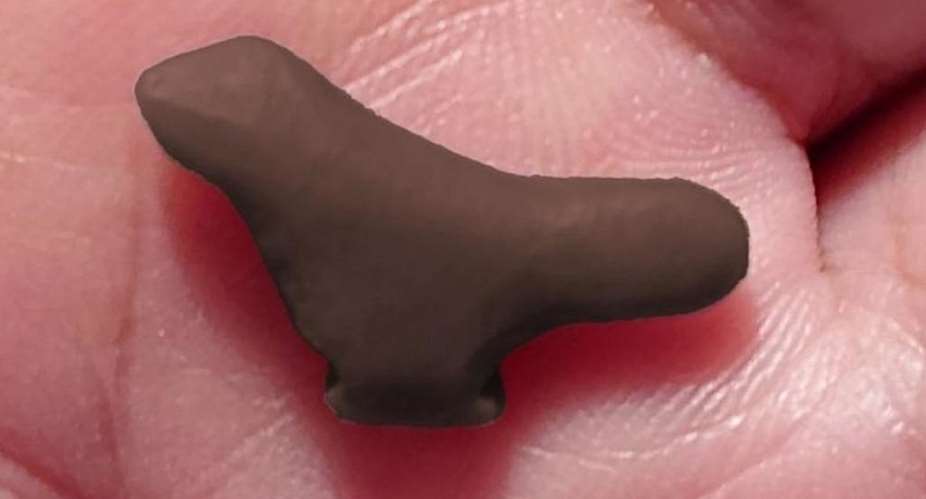A miniature bird carved from bone, found in China, is the oldest piece of three-dimensional art uncovered in East Asia, according to a new report by French and Chinese researchers. The sculpture, no bigger than a coin, dates back more than 13,000 years – evidence that decorative art was practised much earlier than previously thought.
Found at the Lingjing site in China's Henan province, the sculpture of a bird standing on a pedestal, made of burned bone, is very well preserved.
Francesco D'Errico, a researcher for France's National Centre for Scientific Research, based at the University of Bordeaux, published the findings of his international team in the scientific journal Plos One on Wednesday.
The archaeologist referred to the "advanced" technique used to blacken the bone before carving, adding that "the artist was fully aware that a sculpture is the art of finding balance and harmony".
"The sculpture isn't a completely realistic representation of a bird," D'Errico told AFP. "The artist has made the tail slightly larger so that the sculpture can stand upright."
The artist used different techniques and worked on at least 68 parts of the statue, making marks to represent the eyes and the beak.
"It's very small, but in fact it's quite refined," D'Errico said.
Carbon dating
Researchers say it may belong to an original artistic tradition, unconnected to other ancient styles found in Europe or Siberia.
The bird has been dated to the Palaeolithic period, between 13,800 and 13,000 years ago, which pushes back the earliest known date of animal sculpture in eastern Asia by more than eight thousand years.
To determine the age of the sculpture, the researchers used other bones and stone tools found near the sculpture, which had already been analysed with the Carbon 14 dating system.
"We already knew that at this time, hunters and gatherers in China made tools out of bone, and ornaments from shells or animal teeth," explains D'Errico.
"But the sculpture of objects without any obvious function, requiring special technical skills, reveals new information about this ancient society, bringing them much closer to the hunters and gatherers already historically documented." he said.
The earliest known carved human and animal figures sculpted from mammoth ivory date from a much earlier period, up to 40,000 years ago, found in the Swabian Jura mountain range in what is now Germany.
Superior aesthetic value
Until now, however, the earliest animal sculpture found in East Asia dated from around 3,000 BC.
"The bird is perfectly recognisable, it's incredible to think that it was made 13,500 years ago," Li Zhanyang, archeologist and professor at the University of Shandong told RFI.
"We don't know if it originates from here or if it was imported from elsewhere. Older statues exist in Europe and Siberia. But this bird has superior aesthetic value."
The stature is currently at the University of Shandong and will later be put on display in a museum.





 We’ll protect state wealth from opaque deals – Prof Jane Naana
We’ll protect state wealth from opaque deals – Prof Jane Naana
 Mauritania president says running for second term in June polls
Mauritania president says running for second term in June polls
 I won't ever say I was a mere driver’s mate' — Prof. Opoku-Agyemang
I won't ever say I was a mere driver’s mate' — Prof. Opoku-Agyemang
 2024 polls: 'EC struggling to defend credibility'— Prof. Opoku-Agyemang
2024 polls: 'EC struggling to defend credibility'— Prof. Opoku-Agyemang
 Akufo-Addo gov't's 'greed, unbridled arrogance, unrestrained impunity, sheer dis...
Akufo-Addo gov't's 'greed, unbridled arrogance, unrestrained impunity, sheer dis...
 Election 2024: Ghana needs an urgent reset, a leadership that is inspiring – Ma...
Election 2024: Ghana needs an urgent reset, a leadership that is inspiring – Ma...
 Partner NDC to rollout a future of limitless prospects – Prof Jane Naana Opoku-A...
Partner NDC to rollout a future of limitless prospects – Prof Jane Naana Opoku-A...
 NPP will remain in gov’t till Jesus comes — Diana Asamoah
NPP will remain in gov’t till Jesus comes — Diana Asamoah
 Sunyani Technical University demands apology from former SRC president over sex-...
Sunyani Technical University demands apology from former SRC president over sex-...
 'Dumsor' was resolved by Mahama but ‘incompetent' Akufo-Addo has destroyed the g...
'Dumsor' was resolved by Mahama but ‘incompetent' Akufo-Addo has destroyed the g...
